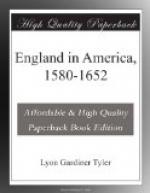These persuasions had at length some effect, and in 1632 Edward Winslow, being sent in a bark to examine the river, reported the country as conforming in every respect to the account given of it by the Dutch and the Indians.[35] Meanwhile, the Indians, not liking the delay, visited Boston and tried to induce the authorities there to send out a colony, but, though Governor Winthrop received them politely, he dismissed them without the hoped-for assistance.[36]
In July, 1633, Bradford and Winslow made a special visit to Boston to discuss the plan of a joint trading-post, but they did not receive much encouragement. Winthrop and his council suggested various objections: the impediments to commerce due to the sand-bar at the mouth; the long continuance of ice in spring, and the multitude of Indians in the neighborhood. But it seems likely that these allegations were pretexts, since we read in Winthrop’s Journal that in September, 1633, a bark was sent from Boston to Connecticut; and John Oldham, with three others, set out from Watertown overland to explore the river.[37]
Plymouth determined to wait no longer, and in October, 1633, sent a vessel, commanded by William Holmes, with workmen and the frame of a building for a trading-post. When they arrived in the river, they were surprised to find other Europeans in possession. The Dutch, aroused from their dream of security by the growth of the English settlement, made haste in the June previous to purchase from the Indians twenty acres where Hartford now stands, upon which they built a fort a short time after. When the vessel bearing the Plymouth traders reached this point in the river, the Dutch commander, John van Curler, commanded Holmes to stop and strike his flag. But Holmes, paying little attention to the threats of the Dutchman, continued his voyage and established a rival post ten miles above, at a place now known as Windsor.[38]
Meanwhile, the ship which Winthrop sent to Connecticut went onward to New Netherland, where the captain notified Governor Van Twiller, in Winthrop’s name, that the English had a royal grant to the territory about the Connecticut River. It returned to Boston in October, 1633, and brought a reply from Van Twiller that the Dutch had also a claim under a grant from their States-General of Holland.[39] In December, 1633, Van Twiller heard of Holmes’s trading-post and despatched an armed force of seventy men to expel the intruders. They appeared before the fort with colors flying, but finding that Holmes had received reinforcements, and that it would be impossible to dislodge him without bloodshed, they returned home without molesting him.[40]




